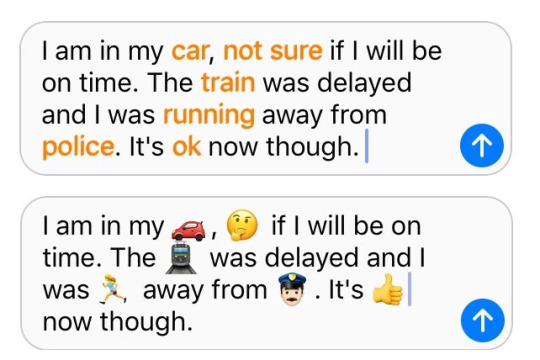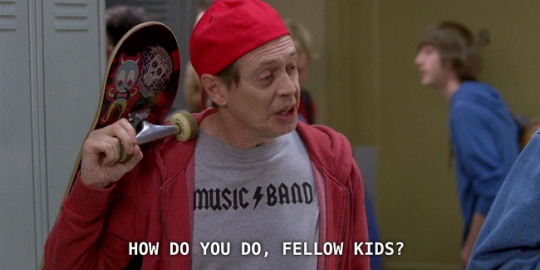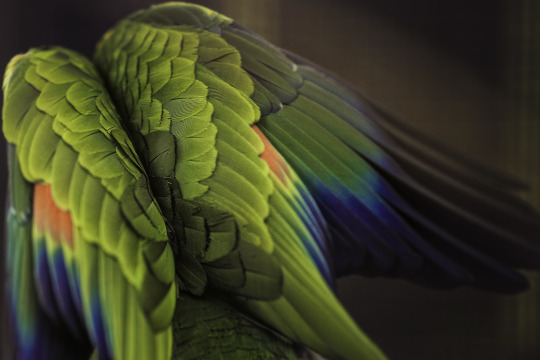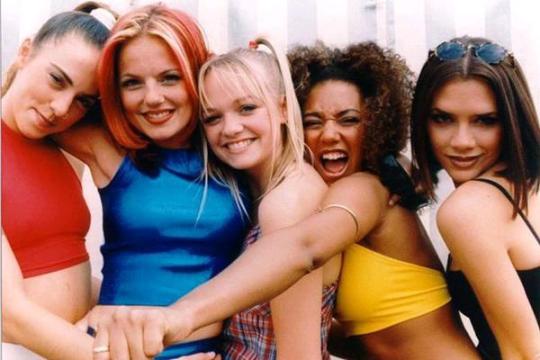Text
In celebration of emojis (but why brands still probably shouldn’t use them)
Actually, one of the really interesting things about emojis is how abstractly they’re used, given how they are a literal picture of one thing. (Originally posted on Medium during my time at The Leith Agency, in March 2017.)
Millennials love emojis. We’re killing language by replacing words with tiny icons, right? Not so much. I’m not going to defend them here, but rather talk about how we use them and why brands should exercise emoji caution.
Let’s start with how we don’t use them. There seems to be a misconception that emojis are used in the middle of sentences, replacing words. Technology giant Apple has fallen victim to this idea, implementing the ability to directly replace words in your texts using their emoji suggestions. It’s fun, but it completely misunderstands how people use emojis. As this brilliant article puts it, it’s the beginning of the ‘nounification’ of emojis: reducing emojis to an obvious and extremely literal meaning, based on what they look like, rather than the fantastically creative ways in which they’re used at the moment:

Actually, one of the really interesting things about emojis is how abstractly they’re used, given how they are a literal picture of one thing.
To explain, let’s dive a little into linguistics…
In linguistics, we often refer to words as signs: they are used to signify something. This term was coined by Saussure, the father of modern linguistics. According to him, “the sign is arbitrary” — that is, the form of the sign has no relation to its meaning. For example, nothing about the word ‘chair’ actually has anything to do with a piece of furniture you sit on. But this is not true for all words, and in language we do have examples of what we call “iconic” signs — signs directly related to their meaning. In English, they’re very rare and largely relegated to the realm of onomatopoeia and words for sounds. Bang, woof, quack, boing. In sign languages, they’re much more common. Sign language is just as expressive as any other form of language and the gestural, iconic signs are used like vocal words. Though they are iconic, there is not a simple form to meaning mapping. Emojis are similar.
For example, the infamous aubergine and peach emojis. They are quite clearly representative of real world objects, but are hardly ever used to talk about those things — and let’s be real, when was the last time you took to Twitter to talk about that rad aubergine you saw in Tesco last night? That’s not to say that you can’t use them in that way (and your mum probably does) but, if you did, it would be easy to tell from context whether you meant aubergine or the latest Calvin Klein advert. They’re definitely euphemistically iconic with the peach resembling a pair of particularly round buttocks. However, we don’t just use it to say “buttocks”, we also use it to say something more akin to “attractive and well endowed”. At the moment, most people use emojis in a really organic, natural way. They’re rarely used mid-sentence, but often at the end of one to intensify or signify mood, or to clarify a witty punchline. They’re the written equivalent for the extra ways we express meaning in speech. Written language lacks certain features found in spoken language — in particular what we do to express ourselves without words (known as supralinguistic features). Things like tone of voice, gesture, expression — the bits that provide context. Far from being simple, fun little pictures used in a basic way, emojis are often the written equivalent of body language and other supralinguistic features that accompany spoken language.
We’re just starting to get to the point where you have to specifically learn meanings associated with emojis; we have to acquire them as a part of our vocabulary. Like any other kind of language acquisition, it seems to be much easier for young people. They are the native speakers of emoji. Even as a tech and language loving 24 year old, I don’t feel fluent, and this is the crux of my point — brands should be very careful about using emojis.
Social media makes it easier than ever for brands to show off their personality, to make informal asides and non-sequitur quips. But as anyone who’s ever tried talking to their thirteen year old niece knows, there’s no easier way to elicit an eye roll from a young audience than by trying to get on their level and failing miserably. They’re savvy, and very quick to reveal you as an imposter. Using emojis poorly is the equivalent of asking that thirteen year old if they’re a fan of Gareth Gates. Will they appreciate you speaking to them in their own language? Maybe, if you do it really well. But probably they’d prefer it if you respected them and their intelligence enough not to try and hoodwink them. There’s nothing worse than a phoney attempt at coolness.

We’re told time and time again that what millennials crave is authenticity. So be authentic, and be your version of cool. That might mean using emojis, and if that’s authentic to you and your brand, awesome. But not using emojis doesn’t mean you’re not trendy, or that you can’t engage young people. All it means is that you’re smart enough to recognise they’re not a natural part of your vocabulary.
That being said, some people and brands can make it work. By all means, if you have a fluent speaker and it suits your brand, go for it! But bear in mind how you should be using them. The way we all use language is organic and fluid, and a whole lot more exciting than a simple meaning mapping onto a symbol. Let’s remember that and celebrate it when we use emojis. They’re not words, but even if they were, they can be so much more complex and joyful than 🐸 = frog. 🐸 = sassy, sarcastic, none of my business. (And also, occasionally, frog.)
Some interesting further reading about emojis:
http://fusion.net/story/347026/ios-update-emoji-pink-shirt-girl/
https://twitter.com/botmoji
http://emojipedia.org/
http://theweek.com/articles/591378/emoji-word-
0 notes
Text
This Article Will Change The Way You Think About Clickbait Forever!
(Originally published during my time at The Leith Agency, in September 2017)
I was recently perusing the latest Teen Vogue political journalism masterpiece (no, really). When I came to the bottom of the article, I was greeted by the usual suggestions of other articles I might want to read. As always these days, the titles were clickbaity.

Part of me — a large part, the part that’s usually dominant — is screaming words dripping in sarcasm. Lord forbid I’m making an eyebrow mistake! But there’s another part, the one that’s normally buried deep down, asking if there even are 15 mistakes you can make with eyebrows, and then again what if my eyebrows are a bit shit? And so I click. And in a new tab I also open the one about the benefits of sleeping with my hair in a bun because honestly, I’d love to read the opinion of someone who is probably equally as unqualified to talk about hair as I am.
(Fear not, it turns out my eyebrows have not undergone any major catastrophes.)
But why did I click? I knew perfectly well that it’s not a subject I’m particularly interested in. Anyone who’s ever met me knows my usual aesthetic is ‘scruffy at best’. I also knew that it was clickbait, and that the contents would be disappointing. And yet, here we were. Again.
So, deeply disappointed in myself and coated in my own self loathing, I did some digging, and it turns out there’s actually a fair amount of research on clickbait (it was even mentioned on a recent episode of QI) and it’s fascinating stuff.
Is anyone immune to clickbait?
We all know someone who, whenever the subject comes up, will smugly proclaim ‘Oh, I never click on that rubbish. I can’t imagine why anyone would.’ They’re just better/smarter/savvier than that. But the truth is that we know clickbait works. There are whole websites that rely on it and reputable news publications are increasingly using it to pad out their offerings and increase website views.
Diply claims to generate 1 billion video views on Facebook and 150 million unique website visitors per month. Given that they sell advertising space, it’s fair to say that clickbait is big business. So claiming that clickbait doesn’t work just isn’t going to cut it with me and the science backs me up. So what are the key reasons clickbait works?
Curiosity and Dopamine
Studies have shown that the reason clickbait is so alluring is partially down to dopamine responses (the body’s reward system). So if someone’s claiming to be completely immune, chances are they’re either lying or joyless. Dopamine is the chemical in our bodies that makes us feel good, and the levels of it rise when we find something good. It’s hella addictive. But interestingly, we release dopamine in anticipation of a reward, not when we receive the reward itself.

Kanye’s probably immune to clickbait.
Additionally, dopamine is the impetus to do the work to receive the reward (in this case, clicking the link and navigating through sixteen pages of pop-up ads and auto-play videos). So we don’t actually need to see the cute or funny or shocking thing in order to feel good about it, but feeling good about it is what makes us click the link in the first place. So those particular clickbait headlines, the ones that add a “#23 will appall you!”, are especially effective; it’s anticipation that keeps you clicking through.
And even worse, we’ve been set up by our own bodies. Dopamine levels grow even higher when there’s a chance that there won’t be a reward at the end of our work (as we all know there probably won’t when it comes to clickbait). Psychologists and neuroscientists call it intermittent reinforcement. When we introduce a ‘maybe’ factor, that addictive surge fills us like never before. This explains gambling, but it also explains clickbait. We’re addicted to the fact that maybe it won’t be good. We’re slaves to our own curiosity.
The Information Gap
Further to this, behavioural economist Loewenstein describes an ‘information gap’. This takes a similar approach in that it has the same end point — that curiosity, and especially its intensity, is driven not by the satisfaction of obtaining information, but by the pain of not having it. There is therefore pleasure in the anticipation of obtaining it.
Studies have also found that guessing and feedback increase curiosity. In a sense, many clickbait headlines pose a question (What do these child stars look like now?). Readers may have an idea of what the answer is and, by internally guessing, their curiosity increases. The information gap has now widened to include whether or not they’re correct.
In studies on deprivation, researchers have also found a link between deprivation and impulsivity. Loewenstein links this to the impulsivity we see in curiosity situations; we’re curious when we see clickbait so we impulsively click on it, without stopping to consider if it’s clickbait. Anyone who’s ever fallen into a Wikipedia hole knows this to be true — you go on to find out whether cuttlefish sleep and through clicking on interesting links somehow end up learning about the black market organ trade, also reading about every living member of the Dutch royal family on the way.

Actual footage of me in a Wikihole.
The Language and Tropes of Clickbait
It’s all well and good to understand the dopamine responses that curiosity elicits, but how is curiosity elicited in the first place? The headlines of clickbait articles are written in such a way as to pique that curiosity, and the pictures are too. One of the major tropes of clickbait is a partially obscured picture — clearly linked to copy that throws up an information gap (You’ll Never Guess What This Teacher Bought For Her Class! I Was Shocked!), but with the information gap part obscured, only increasing the urge to click.
Writing these headlines is not so much an art as throwing shit at the wall and seeing what sticks. With the rise in technology, websites can serve you the same article with 20 different headlines and simply eliminate all but the one that works best. Nevertheless, there is skill attached to good clickbait headlines, and you’ll also see certain ways of phrasing used repeatedly. These often take advantage of the things we’ve mentioned above: information gaps, taking advantage of emotion (including disdain) and using lists.
But it’s not just the content of the headline that draws you in, and what’s particularly interesting to me are the ways in which grammar and semantics are manipulated to grab your interest. Clickbait headlines frequently follow specific patterns, which are really odd compared to everyday language. They often refer to a specific person or persons by only a pronoun (e.g. he, she, they). That’s super weird when you don’t actually know who they’re referring to. In linguistics, it’s called a deixis: it’s a word or phrase that cannot be understood without further contextual information.
Consider the two following headlines, both clickbaity:
1. ‘She Gave This Bear A Pair Of Headphones… What Happened Next Will Shock You!’
2. ‘A zoologist gave a grizzly bear a pair of headphones… what happened next will shock you!’
While it’s written in an annoying way, I’d argue that the first is more successful in grabbing your attention and getting you keen(ish) to find out more. This is for a number of reasons, but key among them is the use of deixis. There are a couple of ways deixis are normally used — anaphora and cataphora — and this headline sort of defies both of them.
The first headline would be completely normal in situations where there was some text preceding it, which explained who the reference was in ‘she’ (e.g. ‘A zoologist was doing some research on grizzly bears and their reactions to music. She gave…’). This is called anaphora — where the deixis in a sentence or clause refers to some information that came before. That’s fine. We’re cool with that. Cataphora is sort of the opposite — it’s where a deixis refers to some information which will come later in the discourse. It’s a little stranger to explain, but it happens a fair amount, especially in rhetoric, literary prose, or storytelling. The reason it happens more in literary prose and story telling is that it adds an element of suspense. We’re also pretty cool with that.
What clickbait does is to separate the deictic words from their cataphor — you’ll find out what they refer to, but only if you click on the link. It’s not something we normally see, so it throws you off a little bit. And like an open bracket that never closes, it makes you a tiny bit stressed. We’re not so cool with that. By not giving up that contextual information we need to understand ‘she’ or ‘this’, the headline effectively and infuriatingly adds further curiosity.
What does this actually mean, though?
As advertisers, we cannot ignore the fact that clickbait exists primarily to allow its publishers to thrive on advertising money. In a sense, we fund and pay for clickbait (and as part of that, fake news). Guilty as charged, we’re proliferators of evil (but we already knew that). A question to ask ourselves is whether we’re able to reclaim clickbait and harness it and its techniques as a force for good. So what, if anything, can we learn from clickbait?
Loewenstein suggests that the information gap could be used to motivate learners in educational settings, by drawing attention to what they don’t know. It’s an interesting point, and could hint towards clickbait as a force for social good. For those of us in the business of behaviour change advertising, there are real questions to be asked about whether we can learn from clickbait in inciting our targets to learn for themselves. Am I suggesting that the answer to all social good is clickbait? Absolutely not, it’s still fairly abhorrent, but I do think there are learnings to be had — certainly in terms of our approach and possibly from the way we use language (even if it’s just manipulating cataphor better).
It may also be useful when we’re trying to solve particularly modern problems. In our recent campaign for the Scottish Government, our aim was to educate the Scottish public about the introduction of new legislation against the non-consensual sharing of intimate images (NCSII) — commonly known incorrectly as revenge porn. NCSII is not a new thing — people have been doing it since we had cameras — but it’s become more of a problem in recent years due to the ease of dissemination through internet channels. It made sense that we would talk about it on the same channels our audience are likely to encounter it and proliferate it, and potentially in the same salacious tones that make people so morbidly fascinated by it.
In came clickbait.
With headlines like ‘Her Boyfriend Shared This Video Of Her Online…You’ll Never Guess What Happens!’ (spoiler: he gets arrested), we infiltrated our targets’ newsfeeds with authentic looking clickbait to pique their interest and get them clicking. On the other side, a ‘trojan horse’ ad — starting off looking like an authentic homemade video (we shot on an iPhone 4), we see what looks like the beginning of a sexual act, with our female actor placing handcuffs on the wrists of our male actor (who, for authenticity, was also the cameraman). A quick cut later and the fluffy handcuffs have been replaced by real ones, his girlfriend by a stern policewoman.

A still from the campaign. By luring people in using curiosity gaps and the implied promise of the very thing we’re legislating against, we hope we can encourage them to examine their own behaviour (which will ultimately prove more effective than lecturing and finger wagging). Companies are already using clickbait to sell their products, I can’t help but wonder if we can use it in a more worthwhile way, as we did for our NCSII campaign.
Given that viewing clickbait is itself viewed as a shameful act, can we use that to our advantage, to access topics that people find hard to talk about? Clickbait taps into morbid curiosity, it’s car crash internet. Let’s take a long look at how we can take advantage of that, rather than simply dismissing it as an annoyance to avoid. I’m not saying clickbait is good, or even that it’s not annoying, but it’s unlikely to go anywhere anytime soon — so let’s at least take it seriously (even if it does make our copywriters want to vomit).
And to finish on a lighter note, my favourite piece of (parody) clickbait, which delivers on its headline in spectacular fashion by presenting you with the entire text of Moby Dick: ‘The Time I Spent On A Commercial Whaling Ship Completely Changed My Perspective On The World’. Plus, my current favourite Facebook page, TL;DR, who helpfully summarise clickbait articles so you don’t have to click on them. Not all heroes wear capes.
0 notes
Link
“Statements such as Wood’s are inflammatory because of the perception that the people he is referring to are a dangerous, criminal element within society. There have long been calls to stop using the term “illegal immigrant” because of the way it dehumanises and conflates the breaking of immigration rules with criminality.”
0 notes
Text
I always see people commenting on lighter news stories online going "how is this news?" I can only assume these people have never read beyond the front page of a traditional newspaper. This shit has genuinely always been news. Back in your box, faux outrage.
0 notes
Photo


Starting a wee series on bird wings, I think. These make great desktop backgrounds.
14 notes
·
View notes
Text
When I was wee, I was pure into the space ghettos
An exploration of why saying “space ghetto” in an American accent sounds like a Glaswegian saying “Spice Girl”
Recently a viral tweet has been doing the rounds, where one user pointed out that if you say “space ghetto” in an American accent, it sounds like a Glaswegian saying “Spice Girl”. Turns out it’s true! The most proper English fellow can be magically transformed into a ned from Airdrie, expressing his love for a ‘90s girl group promoting plastic feminism. It’s the dream, it really is. But quite apart from being a fun party trick, it’s also a really interesting example of phonemes and how the same sounds can behave quite differently across different dialects of the same language.

This may, or may not, be the original tweet. It’s the earliest I could easily track down, but please correct me if it’s not! @fairlyoddgraeme
First, for the linguistically uninitiated, an explanation of what phonemes are and how they work (linguistics has a lot of jargon, making it really excellent for sounding more intelligent than you really are). Quite simply, a phoneme is a unit of sound that is used to distinguish one word from another in a language or dialect. The way we can identify phonemes is through a test called the “minimal pair test”: – we compare words that are exactly the same with the exception of one sound and see if that sound-change signals a change in meaning. For example, cap and cat are clearly different words in English, so we know that p and t are different phonemes.
Now, phonemes are basically a kind of abstract mental representation of sounds and their mappings – for example, if you say the words “milk” and “lark” (and here I really am suggesting that you do say them out loud, or at least mouth them) and pay attention to the position of your tongue when you make the “l” sound, you’ll probably notice that they’re completely different. That’s because in lark it’s a “clear l” while in milk it’s clear l’s more emo cousin, “dark l”. The great thing about this is that in your head, despite being actually completely different sounds, they both represent (or map onto) the same concept: l. If someone used the clear l in milk (and some dialects probably do), we’d still know they were saying milk. Try it. It sounds kinda weird, but in all honesty you probably wouldn’t even mention it if someone did it.
What we’re seeing in the spice girl/space ghetto example is basically the same idea, but turned on its head. Instead of different sounds representing the same concept, we have the same sound representing different concepts. The sound we’re talking about is an alveolar tap (it can also be called a flap, but I’m too juvenile not to snigger every time I write the word “flaps”). In a Scottish accent, this can be used to represent the phoneme “r”, while in an American accent it generally represents “t” – in words like city, for example. There’s obviously more going on here than just this one sound. There’s the vowel in space/spice, though it’s fairly easy to see that these are made in very similar parts of the mouth space. Plus vowels are pretty fluid anyway (to an extent, obviously, you can’t just make any vowel sound and assume everyone will know what you’re talking about).
The o/l distinction is actually where the space ghetto/spice girl example falls apart a little bit. If you’ve ever listened to a Weegie, you’ll know that they quite often use a clear l at the end of words. This kind of relies on a dark l, which is said with the tongue at the back of the mouth – which is also where you make the o sound, meaning it’s easy enough to conflate the two.
The thing I think is genuinely very cool here, is that we’re able to keep the phonemic inventory from other dialects in our heads. We understand that when a Weegie says [speɪs gɛ.ɾɔʊ] they mean Spice Girl, but when an American says [speɪs gɛ.ɾɔʊ] they mean space ghetto. Our capacity for understanding is pretty extraordinary.

Further accessible reading: General American accent - https://en.wikipedia.org/wiki/General_American Standard Scottish English accent - https://en.wikipedia.org/wiki/Scottish_English Phonemes - https://en.wikipedia.org/wiki/Phoneme
1 note
·
View note